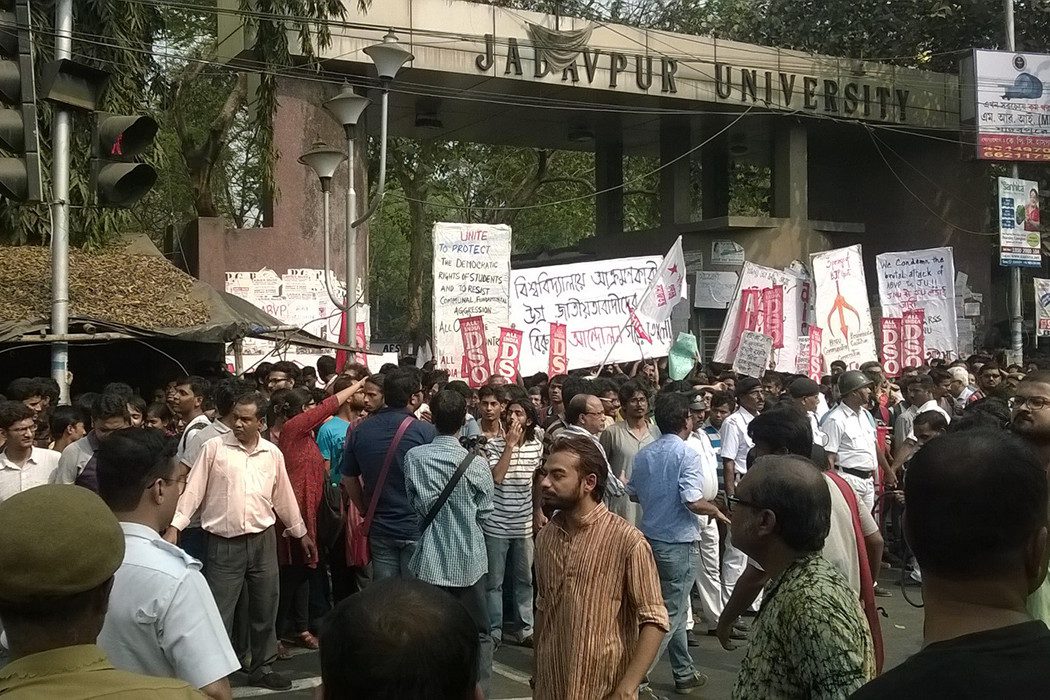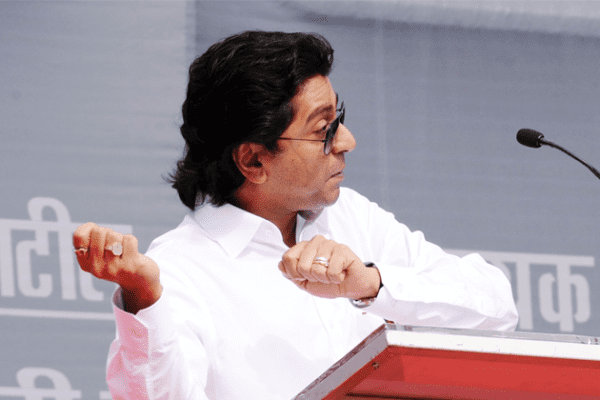Jadavpur University repels a threatened “communal thrashing” by the ABVP, but fissures within the student body suggest tensions are unlikely to abate soon, says Ajachi Chakrabarti.
The Kanobis—as the inveterate punster in me insists on calling OB vans—start at Thana Crossing, near the United Students’ Democratic Front’s graffito condemning the slaughter of innocent children in Syria that I use as a landmark to move towards the front of the bus before getting off at Gate No 4 of Jadavpur University. The media is out in full force this Thursday morning, which is threatening to turn into the hottest day of the year so far. And I’m not just talking about the temperature; today, the great cultural war engulfing the nation comes to JU. Shit is going to get real.
The USDF graffito is one of the things I respect about JU. It’s been around for years, well before last summer’s refugee crisis brought what the UN calls a “humanitarian calamity” and “the great tragedy of the century” to the front pages of the world’s newspapers. It’s testament to the engagement the students of the university have maintained with the great tragedies of modern history. It’s evidence of empathy and solidarity, however symbolic, extending beyond the campus walls, which are perennially covered with graffiti and posters denouncing this injustice or condemning that atrocity.
On Wednesday evening, many of these posters were vandalised by a mob of students and ABVP workers incensed at “anti-national” slogans being raised by a section of students during a protest march the evening before. The chants had been caught on camera, and were the focus of Arnab Goswami’s—and by proxy, the Nation’s—ire Tuesday night. The state BJP was quick to seize on the moment, holding protests on Wednesday in the north Kolkata neighbourhood of Jorabagan against the “traitorous and communal Left and Congress’s conspiracy to tear the country to pieces and turn the nation’s university campuses into arenas for anti-national activities”.
Talking to reporters later in the day, Rahul Sinha, the former state president of the party who is now a national secretary, said that what the students who raised the slogans “need is a good thrashing; only then will they understand the true value of nationalism.” He predicted that “the people” would dispense said thrashing in the days to come.
Talking to reporters later in the day, Rahul Sinha, the former state president of the party who is now a national secretary, said that what the students who raised the slogans “need is a good thrashing; only then will they understand the true value of nationalism.” He predicted that “the people” would dispense said thrashing in the days to come; right on cue, the ABVP announced a march to the university campus for the next day. Overnight distress calls and status updates on Facebook have mobilised hundreds of students, faculty and alumni to gather at Gate No 4 this Thursday morning, as the campus girds up its communal loins to face down the fascist threat.
The slogan in question was the popular Kashmiri call-and-response chant for azadi that, ever since they watched Sanjay Kak’s Jashn-e-Azadi, the university’s students have appropriated for use during demonstrations. It was used during the 2013 gherao of Vice-Chancellor Souvik Bhattacharya and other staff after the suspension of two engineering students for ragging. During the boycotted convocation of December 2014, at the height of the Hok Kolorob movement, a then-second-year production engineering student called Parminder Singh marched next to a rickshaw with a speaker mounted and delivered a truly heartfelt rendition of the chant outside the Open Air Theatre, drowning out the convocation proceedings as students outside and inside the theatre joined in (replacing Kashmir with Jadavpur, of course).
During Tuesday’s march, organised to protest the State’s crackdown on JNU, a political group that calls itself Radical, a breakaway faction from the USDF, used the chant for its original purpose—to advocate for independence for Kashmir. “Yes, we are unambiguous in our support for independence for Kashmir, Manipur and Nagaland,” a pamphlet the group hands out on Thursday proclaims. “Yes, we consider Maqbool Bhatt and Afzal Guru martyrs in the struggle for Kashmiri independence. Yes, we believe they were murdered by the State. Even with the cloud of sedition hanging over us, we stand up and express our belief in the midst of the emerging emergency throughout the country.”
Even if one were to disregard the argument that policing thought and opinion is the first step towards totalitarianism, their views by no means reflects the official—or even majority—position of the students of Jadavpur, and many student groups have distanced themselves from the slogans.
Even if one were to disregard the argument that policing thought and opinion is the first step towards totalitarianism, their views by no means reflects the official—or even majority—position of the students of Jadavpur, and many student groups have distanced themselves from the slogans. Like in the JNU public meeting on 9 February, which precipitated the crackdown there, it was just a portion of the crowd that responded to the chant, raised by a handful of students.
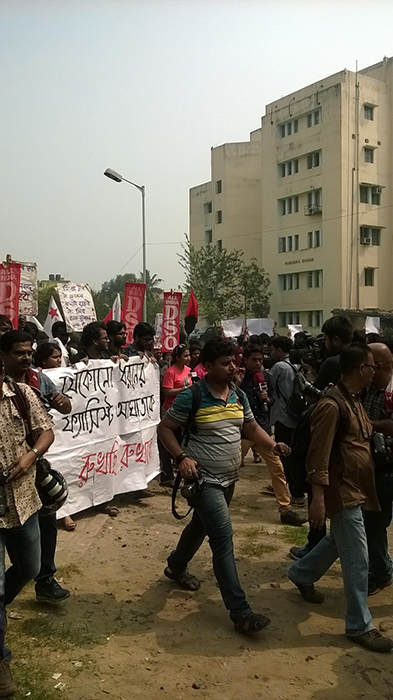
Such nuance, however, was lost on a section of the university’s engineering students. On Monday, a general body meeting of the Faculty of Engineering and Technology Students’ Union, attended by around 60–80 students, had resolved to condemn both the police action at JNU, which in a communique addressed to the JNU Students’ Union it called “a direct attack on the democracy of the campus”, as well as the raising of “slogans like ‘Pakistan Zindabaad’ and ‘Bharat ki Barbadi tak jang rahegi jaari’, as these kinds of slogans in their content confront the sentiments of the common people of the country and not the state machinery.”
After the sloganeering at Tuesday’s protest made headlines, though, rumours began spreading among the engineering students that FETSU had organised the rally and that it condoned, if not outright supported, the call for azadi. Another general body meeting was called, this time attended by close to 500 students, where slogans were raised against the union, which has for years been controlled by the leftist—but nonpartisan—Democratic Students’ Front. The students raising the slogans were not ABVP cadres, at least the card-carrying kind; the RSS’s student wing does not have formal representation in the university and doesn’t contest elections. They abused the union leadership, called them traitors and claimed the union would die a dog’s death.
After the sloganeering at Tuesday’s protest made headlines, rumours began spreading among the engineering students that FETSU had organised the rally and that it condoned, if not outright supported, the call for azadi.
About an hour into the meeting, this group exited and attempted to march towards the arts faculty buildings with the intention of tearing down posters put up by Radical, such as one that said “If the mass murderers of Gujarat and those who sentenced Afzal Guru and Yakub Memon to death are patriots while the students agitating for Kashmiri independence are traitors, then we are traitors.” They were thwarted, however, by other students, who closed ranks around them and chanted slogans until they left. The students then delivered a representation—on official FETSU stationery, though they were not authorised to do so—to the vice-chancellor condemning the anti-national slogans, and returned to the general body meeting, which broke up after four hours without coming to any conclusions.
Following the meeting, allegedly bolstered by ABVP cadres from outside the campus, a group of students went on a rampage around 7 pm. Many students had left by then and the Arts Faculty Students’ Union was holding a general body meeting at the time to determine their response to the provocation earlier in the day, so there wasn’t much resistance to the mob. Those who tried were pushed or assaulted, including some female students. Besides the Radical posters, the agitators, chanting slogans like “Bharat Mata ki Jai!”, vandalised many other banners, most of them put up by the Students’ Federation of India that, rather than glorifying terrorism or advocating the destruction of the country, were condemning deaths in the tea gardens of north Bengal, the spate of farmer suicides across the country that BJP MP Gopal Shetty would call a “fashion trend” the next day, the rise of Hindu fascism, and various other anti-people policies of the state and central governments.
Much of the damage is still visible on Thursday morning, though new posters are being painted challenging the fascism of the RSS/BJP. As the many media crews muck around, waiting for things to start happening, collecting bites and recording pieces-to-camera, the students and teachers are gathering, sharing news, cracking jokes. No one seems sure of what is about to happen, whether the ABVP will really come and how many of them if they do, whether the agitating students from the day before will play a part, what role the police will adopt should they show up. Once a sufficient crowd has been gathered and the ABVP still nowhere in sight, the decision is taken to march around the campus.
No one seems sure of what is about to happen, whether the ABVP will really come and how many of them if they do, whether the agitating students from the day before will play a part, what role the police will adopt should they show up.
The AFSU general body meeting the day before had been volatile, with the two major groups that vie for control of the union, the SFI and the Federation of Arts Students, having a heated debate over whether their subsequent protest march to condemn the incident would be bannerless or not. Although it was agreed that the political groups would not carry their flags, a few SFI cadres smuggled in their banners, which they raised during the march, almost leading to fisticuffs.
Today, in the face of the imminent external threat, the groups have agreed to allow party banners, and the procession has the participation of both FAS and SFI, as well as the Democratic Students’ Organisation and the All India Students’ Association, among others. As they walk towards the OAT, double back, then past the engineering faculty and administrative buildings and back to Gate No 4, different sections chant different slogans at the same time, cycling through the greatest hits of leftist protest slogans. The chants are interspersed with invective-laden shouts asking people behind them to catch up or those ahead to slow down.
There’s the “Halla Bol” call-and-response chant inviting the people to raise their voice in various degrees of intensity, and the “Jab lal-lal lehrayega, tab hosh thikane aayega” slogan that promises a socialist utopia. The nonpartisan FAS favours the iconic slogan of the Chilean popular unity movement, “¡El pueblo unido, jamás será vencido!” which, for reasons best known to them, they translate as “The people united will…always be victorious,” causing me to cringe every time I hear it. There’s Bismil’s ‘Sarfaroshi ki Tamanna’ rendered as a call-and-response slogan. There’s the belligerent “Hamse jo takrayega, woh choor-choor ho jayega.” There’s also an innovative riff on the infamous Sanghi slogan from the Babri Masjid demolition: “Shiksha bechne walon ko, ek dhakka aur do.” Conspicuous by its absence is the controversial “Azadi” chant; the Radical activists try raising the slogan a couple of times, but there are no takers when one of them shouts “Afzal mange—”. Inevitably, though, the Times Now crew is right on the spot when the attempt is made.

As the march winds its way through the engineering faculty premises, passing the crowded canteen and playing field, few—if any—of the many students milling about join in. Most of them ignore the procession, a few look sardonically, one rolls his eyes when he hears one of the slogans calling for raising a red flag at the Red Fort.
There are no banners belonging to FETSU or the DSF to be seen in the march, though some engineering students are participating in their individual capacity. Some of the protesters express concern that they might be attacked from both sides, though the word is that after the dissident students had threatened to act independently of the union the evening before, they were told, “Sure, go ahead. But don’t come to us when you want exams postponed or a supplementary exams sanctioned,” a threat that many are convinced will keep the students in line. Nevertheless, there is a minor kerfuffle when someone alleges that a group of students who were present in the mob the day before is present in the crowd at Gate No 4.
Later in the day, as I am making my way out of the campus, I chance upon a group of engineering students airing grievances to their seniors, some of whom are FETSU office bearers. Aided by a recent haircut and shave that lets me pass myself off as a student, I join the group to eavesdrop. (Although they complain often during the discussion that the media distorts their message, none of them are willing to talk to me once I own up to being a journalist.)
There is much indignation in this group at the anti-national sloganeering being allowed. “I am ashamed to call myself a JU student,” says one of the juniors.
There is much indignation in this group at the anti-national sloganeering being allowed. “I am ashamed to call myself a JU student,” says one of the juniors. He says he will recommend to prospective students that they’d be better off joining IEM or Heritage—two private engineering colleges in the city—instead of Jadavpur because of the events of the past week.
Such slogans, says another, only hurt the reputation of the college, and therefore their prospects at getting a good job after college; it has long been a common refrain among the engineering students that the political activities of the arts and science students are enabled by not having to bother about such worldly matters as employability. It is also an argument raised by BJP ideologue Chandan Mitra in an opinion piece for NDTV in which he advocates shutting down JNU and restoring the land on which the campus is located to its original purpose of a training academy for IAS recruits.
A third student is incensed that the union would not condemn the use of such slogans. When he is told that it did just that in the general body meeting on Monday, he admits to not having attended it. No one told him about it, it seems. Another questions why student politics shouldn’t be restricted to campus matters only—why, when the university infrastructure is falling apart, do we care about Kashmir or Nagaland?
Another questions why student politics shouldn’t be restricted to campus matters only—why, when the university infrastructure is falling apart, do we care about Kashmir or Nagaland?
The seniors take the opportunity to admonish all of them for not being interested in campus matters before this. You claim infrastructure is falling apart, they say, but when we hold general body meetings over infrastructure issues, only 20–50 people turn up. “I don’t understand,” wrote Mononendu Das, a student of Electronic and Telecommunication Engineering, in a Facebook post on Wednesday night, “how the patriotism of people who never care about anything on campus outside their department building and the placement office is suddenly coming to the fore, how they can complain that they weren’t invited to the GB. I can’t handle people who find out whether classes have been cancelled and go home whenever a GB is called, but are now standing in campus, hurling abuse at their elected general secretary, assistant general secretary and class representatives and calling them anti-national.”
However much you might disagree with the slogans being raised, one senior explains, you have to stand up for the right to freedom of speech. He urges them to go check out other colleges in the state and realise how much better shape their university is in. This is because, he says, Jadavpur has a tradition of students uniting and standing up for their rights against all opposition, something that is enabled by encouraging free and open discussion of all matters.
He doesn’t find much takers for this logic, however, as one student responds with classic right-wing whataboutery—what about our right not to have our nation insulted? Well, you can go complain to the university authorities then, he is told, but violence or vandalism is not the answer. Although his answer doesn’t quite mollify the students, involving the authorities is part of their agenda; it is one of five points they want to call yet another general body meeting in order to adopt as official FETSU policy.
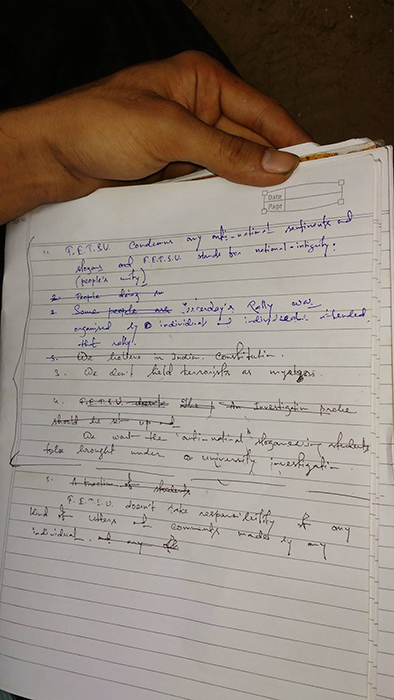
Here are the points, for those who can’t read the handwriting or negotiate the spelling and grammatical errors and the various amendments. (I personally love the Freudian striking out of the original Point No 3.) The memorandum the students seek is as follows:
- FETSU condemns any anti-national sentiments and slogans. FETSU stands for national integrity (people’s unity).
- [Wednesday’s] rally was organised by individuals and individuals headed that rally.
- We don’t hold terrorists as martyrs.
- We want the anti-national sloganeering students to be brought under a university investigation.
- FETSU doesn’t take responsibility of any kind of utterances and comments made by any individual.
“Yaar, can’t we just close down the arts faculty?” one student asks once the coast is clear, only half in jest. “Get the people from the Salt Lake campus to come here instead. Or at least build a wall between us and them.”
As they talk, another march by DSO activists goes by. The group moves to the side of the road, and lower their volumes, looking on the marchers with barely concealed contempt. “Yaar, can’t we just close down the arts faculty?” one student asks once the coast is clear, only half in jest. “Get the people from the Salt Lake campus to come here instead. Or at least build a wall between us and them.”
All of this happens, of course, after the main attraction of the afternoon is over. Earlier, as the delay in the promised noon confrontation grows longer and the mercury climbs higher, the students at Gate No 4 are getting restless. A few climb onto vantage points that allow them to look over the crowd in front of them and seek out the ABVP contingent. There are many false alarms, as the protesters up front, having long given up sitting down, inch their way forward out of the gate, causing the television crews to progressively move back until they become a traffic hazard and the police, who have grown in number, have to step in. But at least we now know they are definitely coming; someone’s mother saw a large procession at Dhakuria.
There is almost an air of relief when they are finally sighted at Thana Crossing. The protesters get to work, gathering just outside the gate and chanting their multitude of slogans, no more coherent than they were an hour ago. The teachers form a protective human chain in front of them. I slip out from behind them; I want to check out who all this hue and cry is about.
I make my way up the road, negotiating both the stalled traffic and the crowd of gawking pedestrians, only to find a group of 50 or so young men. (I don’t spot a single woman.)
I make my way up the road, negotiating both the stalled traffic and the crowd of gawking pedestrians, only to find a group of 50 or so young men. (I don’t spot a single woman.) Some carry tricolours, others ABVP flags. There are framed photographs of Swami Vivekananda, Subhash Chandra Bose and Rabindranath Tagore. One carries a poster with an equation on it: “Communist + Leftist = Break India”.
They are fervently chanting slogans for the assembled television cameras. When I reach them, they are in the midst of a call-and-response chant on the lines of the defamed “Azadi” one. “Kashmir mange—Akhand Bharat! Kerala mange—Akhand Bharat!” You get the drift. They soon switch to “Doodh mango to kheer denge, Kashmir mango to cheer denge”, then “Bharat mein rehna hai, to Vande Mataram kehna hai” and “Bharat mata sharminda hai, deshdrohi zinda hai”, followed by “Har ghar mein ghuskar marenge, jis ghar se Afzal niklega.” I notice with considerable alarm that the number of ABVP flags has gone down, replaced by lathis, which the activists use to keep up a beat.
The cheerleader of the slogans takes a break to do some glad handing, meeting RSS and ABVP workers who have gathered from all over the state. One apologises for coming alone; he’s come all the way from Kalyani, and would have got others from the local shakha given a little more notice. Another expresses his anguish that students of such an elite university would resort to such anti-national slogans. No, it’s a good thing, says the first. All this anti-India sentiment has always existed, now it is being exposed before the nation. Someone makes a vague metaphor about how the crop is ripe for harvest.
“This was only the blast,” he tells me, referring to Tuesday’s sloganeering. “The bomb has been ticking for a long time. These people are against Bharat Mata; it’s like being against one’s mother. But that’s nothing new. They used to have a slogan that we will forget our father’s name, but never forget Vietnam. That’s the kind of people they are—no regard for their parents.”
Bhaskar Mondal, an ABVP activist from Diamond Harbour, informs me that universities like Jadavpur have long had sleeper cells for deshdrohis, who use the students to propagate their anti-India work. “This was only the blast,” he tells me, referring to Tuesday’s sloganeering. “The bomb has been ticking for a long time. These people are against Bharat Mata; it’s like being against one’s mother. But that’s nothing new. They used to have a slogan that we will forget our father’s name, but never forget Vietnam. That’s the kind of people they are—no regard for their parents.”
“The notion of freedom of speech has been abused for a long time in this country,” says Bhaskar Datta, a BJP member present at the rally. “Its implementation has been selective; if it suits you, it is welcomed, but if it doesn’t, it must be suppressed. And so you have Baba Ramdev, for all his merit, not being allowed to speak at JNU, while separatists are.” He claims that most students are aghast at the anti-national sloganeering on campus, and that those who vandalised the posters the day before were not politically affiliated, but of course, “any show of force is condemnable.” Despite Rahul Sinha’s bombast, he denies that they are here to commit violence, claiming that they have come merely to deliver a deputation to the vice-chancellor of the university. Around us, the beating of lathis is getting louder.
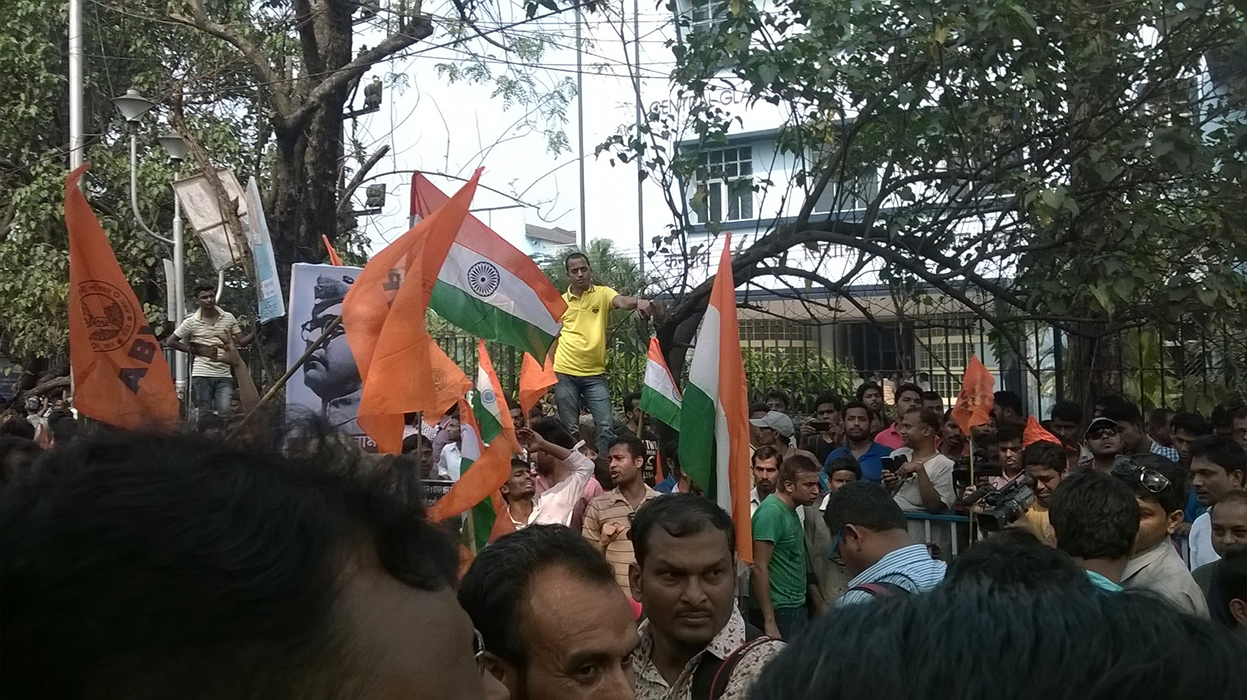
Datta points out the irony of the “ultra-leftists” of the university, who always rail against the excesses of the State, “today hiding behind police barricades.” That is not entirely accurate. Far from being cowed by the threat of a thrashing, the students have spilled out onto the road and are shouting confrontational slogans as faculty and police try to keep them back. The barricades have been set up in front of the ABVP procession by the police to maintain a buffer between the two groups.
As the policemen scramble to block them, their numbers on the street itself dwindle, and a wave of activists takes opportunity to charge the barricades and make a run for it, lathis swinging wildly. Don’t assault anybody, one of their handlers half-heartedly advises them.
The police has, however, neglected to set up a barricade on the pavement, and a group of protesters takes that path to get closer to the students. As the policemen scramble to block them, their numbers on the street itself dwindle, and a wave of activists takes opportunity to charge the barricades and make a run for it, lathis swinging wildly. Don’t assault anybody, one of their handlers half-heartedly advises them.
They make it a hundred yards or so further before they are intercepted by more policemen. A stalemate ensues, with both groups inching forward, but the police calmly maintaining a buffer. For the next half hour, this is how it remains—both groups keeping up their angry sloganeering, as their representatives (JU professors and, I presume, Sangh lawyers) negotiating separately with policemen to get the other group to back down, the media gleefully flitting back and forth in search of great footage, or breathlessly reporting the latest developments to their newsrooms. There seem to be too many policemen and too few Sanghis for any real violence to occur.
In the interim, the discourse descends into petty insults. Dalal, or pimp, seems to be a favourite of the Sanghis; in the course of a minute, I hear the JU professors being referred to as “CPMer dalal”, “Hafiz Sayeeder dalal”, “ISI ke dalal” and “Pakistaner dalal”. “Sarkari poyesha dhongsho korbe,” says one indignant soul, parroting the popular notion that public education in the humanities is a waste of money, “tarpor bolbe Pakistan zindabad.” The mid-afternoon heat is fraying tempers, but also leaching energy, and one senses that something has to give soon.
Dalal, or pimp, seems to be a favourite of the Sanghis; in the course of a minute, I hear the JU professors being referred to as “CPMer dalal”, “Hafiz Sayeeder dalal”, “ISI ke dalal” and “Pakistaner dalal”. “Sarkari poyesha dhongsho korbe,” says one indignant soul, parroting the popular notion that public education in the humanities is a waste of money, “tarpor bolbe Pakistan zindabad.”
All of a sudden, a group of tricolours is spotted on the opposite side of the road—on the other side of the four-foot-or-so-high divider—making its way rapidly towards the traffic signal just outside the university gate. A brief panic sets in; so many students have come onto the street that there is no way for the police to push through and form any sort of buffer. With the help of the professors, they try to cajole the students into moving back into the campus before the group makes its way to the crossing.
I squirm my way out of the great herding operation and head towards an empty space along the divider that would allow me to see clearly what happens. Once I get there, I can’t help laughing: it’s not more ABVP activists coming to beat students up, but a gaggle of 20 or so Congress workers who have come out of nowhere. (I count flags, not people, for they have already been surrounded by enterprising TV crews who’d managed to vault the barrier; a print journalist who, like me, couldn’t be bothered to make the leap, notes that it’s very likely some of them are carrying flags in either hand to make the crowd appear larger.) All they have to say is “Rahul Gandhi zindabad! Zindabad, zindabad!”
Their appearance defuses all the tensions that had been building. Some ABVP activists try to jump the barrier and attack the Congress workers, but the police manages to stop them. The group is so small that the police decides there’s no point holding up traffic on that side of the road, and the row of buses and cars forms a natural barricade between the two groups. Both groups decide they’ve had enough and turn back. The students, a little triumphant, a little bewildered, head back into the campus.
Some ABVP activists try to jump the barrier and attack the Congress workers, but the police manages to stop them. The group is so small that the police decides there’s no point holding up traffic on that side of the road, and the row of buses and cars forms a natural barricade between the two groups.
I decide to follow the ABVP guys for a while, to see whether they end up clashing with the Congress. As we walk, one of the activists pulls a speaker on a sort of trolley, calling out slogans into the mic. “Har ghar mein ghuskar marenge, jis ghar se Afzal niklega.” The youth walking in front of me drops the lathi he is carrying, a disgusted look on his face.
“Kya hua? Why aren’t you chanting?” one of his companions asks him.
“Saala idhar hi nahin ghus sake,” he says. “Ghar-ghar mein ghanta ghuskar marenge?”













